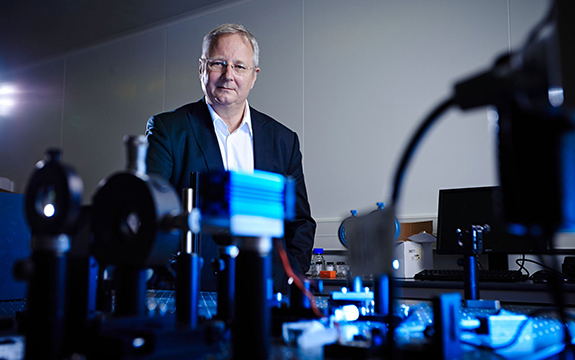29 June 2017
Quantum technology is one step closer to moving out of specialist laboratories and into the palm of your hand.
An international team – involving Swinburne Centre for Micro-Photonics Director, Professor David Moss – has made a major breakthrough in developing a new concept for the generation and control of complex quantum states on microchips and in optical fibre technology, that could ultimately be used in home computers, laptops and smartphones.
The team has just set a new record in the complexity of entangled photons that can be generated on the tiny space of a single chip. These complex optical photon states are critical, not just for improving our fundamental understanding of quantum mechanics, but also for practical applications such as information processing, imaging, and microscopy. They will also help in implementing more sophisticated ultra-secure telecommunications of the future and are expected to speed up progress towards quantum computers.
They demonstrated that optical combs – or optical integrated Kerr frequency combs, to give them their full name – based on a micro-ring resonator, can be used to generate so-called ‘QuDits’ on a chip.
Optical QuDits – the next step beyond qubits – consist of photons that exist in more than two states at a time. By entangling two Qudits – each in a superposition of 10 different states – the group has succeeded in creating an on-chip quantum system with an unprecedented one hundred dimensions.
This breakthrough shows that compact, highly complex quantum state sources can now exist outside of large laboratories, opening the possibility of – ultimately – incorporating quantum devices directly into laptops and cell phones.
“This represents an unprecedented level of sophistication of the quantum states able to be generated on a chip, says Professor Moss.
“Our result is a key breakthrough that, in my opinion, could very well accelerate the quest of achieving so-called quantum supremacy – quantum devices that have the ability to perform functions beyond the capability of conventional computers.
“Further, by achieving this on a chip that was fabricated with processes compatible with the computer chip industry, we have opened the door to ultimately bringing powerful optical quantum computers for everyday use closer than ever before.”
Dr Michael Kues and Mr Christian Reimer from Canada’s National Institute of Scientific Research – Energy, Materials and Telecommunications (INRS-EMT) are the lead authors of this study.
"By combining technologies from both quantum optics and ultra-fast optical signal processing, we not only succeed in generating high-dimensional quantum states on a chip but demonstrate their reconfigurable control ‘on-the-fly’,” Dr Kues says.
“This can have a significant impact on the development of high-dimensional logic gates as well as enabling practical quantum technologies.”
The work, led by Professor Roberto Morandotti at the INRS-EMT, involves a collaborative team from Swinburne University of Technology in Australia, the Universities of Sussex, Herriot Watt, Glasgow and Strathclyde in the UK, the University of Palermo, Italy, the City University of Hong Kong, the Xi’an Institute and the University of Electronic Science and Technology, China, and the National Research University of Information Technologies, Mechanics and Optics, St Petersburg, Russia.
The research has been published in the journal Nature.
Read more about Professor Moss’s work in Swinburne’s 2017 ‘Research Impact’ magazine, produced in association with Nature Publishing Group.













